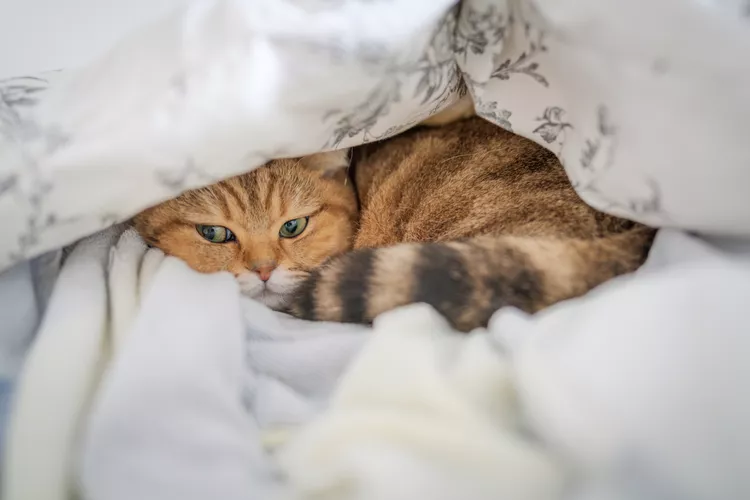Vestibular Disease in Cats

Vestibular disease affects your cat's nervous system and causes incoordination and trouble balancing. You may notice your cat having difficulty standing up, walking normally, and darting its eyes. Sometimes, vestibular disease can cause vomiting and nausea. If you think your cat is behaving strangely, visit your vet. The cause of vestibular disease is usually idiopathic, meaning there is no explanation. It can also develop as a secondary condition from an ear infection, tumor, or toxic medication. Your vet can quickly diagnose vestibular disease by running a series of non-invasive tests and can treat the primary cause if there is one. The idiopathic vestibular disease will usually resolve itself in months. Vestibular disease is thought to be hereditary in Siamese and Burmese cats.
What Is Vestibular Disease?
Vestibular disease is a nervous system disorder that affects your cat's balance and coordination. The vestibular system regulates your cat's balance and the movement of its head and eyes. The vestibular structure is comprised of two components, one located in the inner ear and the other in the lower area of the brain. These components work together to respond to movement and position changes in the cat, instruct the body how to adjust its muscles, and keep the cat from falling over. Vestibular disease inhibits your cat's ability to coordinate its body.
Symptoms of Vestibular Disease in Cats
The symptoms of vestibular disease in cats are usually easy to identify. If your cat cannot keep its balance, visit your vet.
The most prevalent symptom of vestibular disease in cats is incoordination. This can look like a peculiar gait, having difficulty standing up, losing balance, and tipping over. Your cat may also circle to one side, disoriented by its diminished sense of balance. While your cat is stumbling around, you may also notice a head tilt or a rapid eye movement called nystagmus. In addition to darting eyes, your cat may show signs of vision loss, as a normally functioning vestibular system stabilizes vision. Your cat may also exhibit symptoms of nausea, food refusal, and vomiting.
What Causes Vestibular Disease in Cats?
The cause of vestibular disease is usually idiopathic, but there are several possible contributing causes to its development.
Ear Infection
Because part of the vestibular system is located in the inner ear, it could suffer if a cat's ear becomes infected. If your cat develops an ear infection, visit the vet immediately before complications develop.
Tumors
It isn't typical for a tumor to cause vestibular disease, but it's a worthwhile consideration, especially in older cats. Any growth that can impact the inner ear can negatively affect the vestibular system. Polyps function similarly.
Head Trauma
Head trauma can lead to vestibular disease in cats. Blunt force trauma to the brain or ear can permanently damage your cat's vestibular structure. Trauma that affects the brainstem is particularly conducive to the development of vestibular disease.
Ototoxic Medication
An ototoxic medication is a drug that has a toxic effect on hearing and balance nerves. Some medicines are proven ototoxic (which your vet will know not to administer), but others are inconclusive. Never give your cat medication without consulting your vet first.
How Do Vets Diagnose Vestibular Disease in Cats?
Your vet will diagnose vestibular disease by physically examining your cat's ears and looking inside for signs of infection and growths. Your vet will also likely conduct a neurological exam and CT scans or MRIs. Sometimes, spinal fluid will be analyzed.
Treatment & Prevention
The treatment method of vestibular disease in cats relies heavily on the cause. If the vestibular disease is caused by another condition, like an ear infection, ototoxicity, or growth, the vestibular disease will likely go away once the primary issue is resolved. If there is no identifiable cause, the symptoms of the disease will usually improve on their own in a few months.
Managing your cat's symptoms may include anti-nausea medication, living space changes such as low-entry litter boxes, and blocking access to high surfaces.
The best you can do to prevent your cat from developing vestibular disease is to work to avoid the conditions that may lead to it, like taking measures to prevent ear infections in your cat. You cannot prevent idiopathic vestibular disease as the cause is unknown.
Prognosis for Cats with Vestibular Disease
If your cat's vestibular disease was caused by something irreversible, such as permanent brain injury, its symptoms may improve but never entirely resolve. Otherwise, the prognosis is good. Idiopathic vestibular disease typically resolves on its own. The conditions that cause secondary vestibular disease are usually easy to treat. Still, a head tilt may persist even after the illness goes away.
-
How do I keep my imbalanced cat from hurting itself?
If your cat has difficulty balancing due to vestibular disease, it's essential to make safety changes to its living environment while it's healing. For example, make sure your cat cannot access high places where it can fall off.
-
How do I know it's vestibular disease and not a stroke?
Some of the symptoms of vestibular disease in cats are similar to those of a stroke, but strokes in cats are quite rare. Still, if you suspect that your cat has suffered a stroke, visit the vet immediately.
-
How do I know if a medicine is bad for my cat's vestibular system.
Never administer any medication to your cat without checking in with your vet. Your vet will help you choose the safest and most effective treatment for your cat and limit its exposure to any ototoxicity.